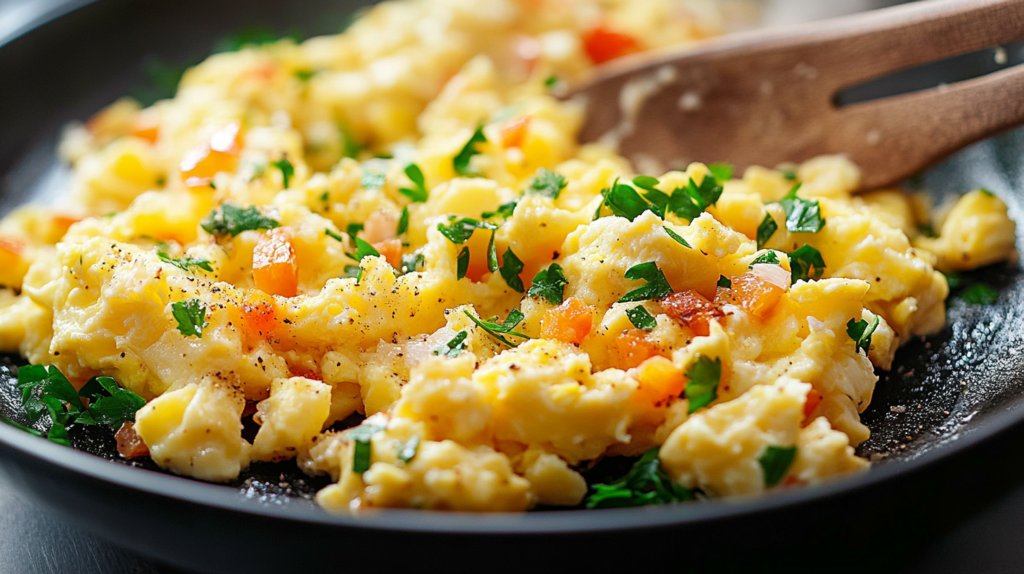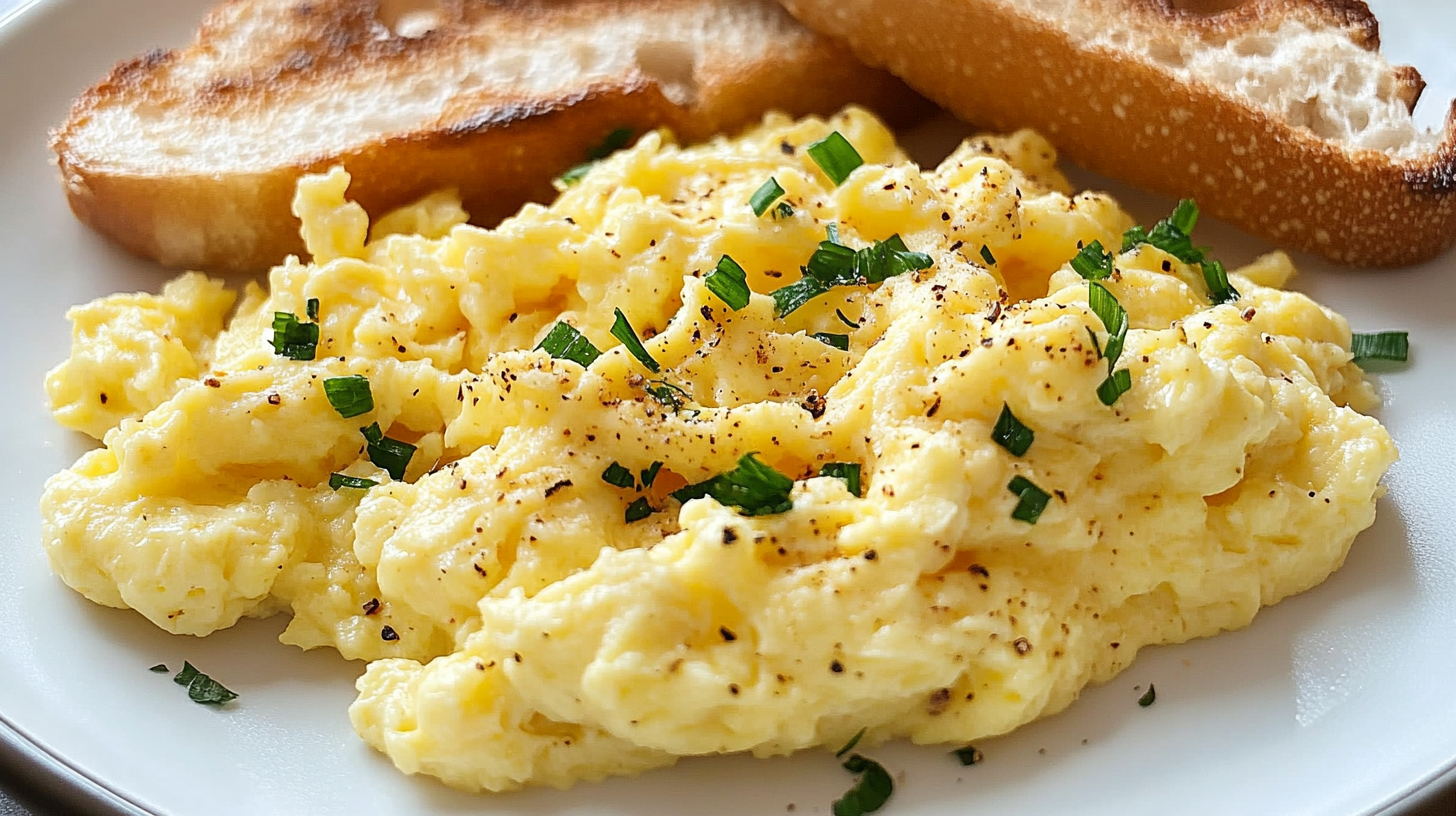Scrambled eggs are a breakfast staple, cherished for their creamy, fluffy texture and satisfying taste. From a quick weekday breakfast to a cozy weekend brunch, scrambled eggs are simple yet versatile, adaptable to every palate. This guide will walk you through the basics of creating the perfect scrambled eggs, including the history of this classic dish, essential techniques, common mistakes to avoid, and delicious variations. By the end, you’ll know how to make scrambled eggs that are perfectly fluffy, rich, and deliciously customizable.
What Are Scrambled Eggs?
A Classic Breakfast Staple
Scrambled eggs are one of the most beloved breakfast dishes worldwide, made by whisking eggs with salt and butter (or oil), then cooking over gentle heat until just set. This technique creates soft, creamy eggs with a delicate texture that practically melts in your mouth. While simple at heart, scrambled eggs are highly versatile, lending themselves to various ingredients and cooking techniques to create different textures and flavors.
Why Scrambled Eggs Are So Popular
There’s something magical about scrambled eggs—they’re quick, easy, and endlessly adaptable. Scrambled eggs can be as basic or as fancy as you want, whether you’re looking for a light breakfast or a protein-packed start to your day. They pair well with other breakfast favorites like toast, bacon, and fresh fruit, making them a mainstay in homes and restaurants alike. And with the right techniques, anyone can master the art of making perfect scrambled eggs.
A Brief History of Scrambled Eggs
Ancient Origins of Scrambled Eggs
Scrambled eggs have been enjoyed for centuries, with variations appearing in different cultures around the world. The concept dates back to ancient times, with early forms of scrambled eggs found in Middle Eastern and Roman cuisine. People used the simple technique of beating eggs and cooking them over low heat, often mixing in herbs or spices for added flavor.
Scrambled Eggs in Modern Cuisine
Over time, scrambled eggs have evolved, influenced by different culinary traditions. Today, scrambled eggs are a common feature in breakfast menus globally, from American diners to European cafés. In the modern kitchen, scrambled eggs are often elevated with ingredients like cream, butter, cheese, or fresh herbs, creating variations that cater to different tastes and textures.
Understanding the Basics of Scrambled Eggs
Essential Ingredients
To make perfect scrambled eggs, you need just a few simple ingredients, each with a key role in the final result:
- Eggs: Fresh eggs are the foundation; choose high-quality eggs for the best flavor.
- Butter or Oil: Butter adds richness and a silky texture, while oil is a good alternative for dairy-free versions.
- Salt: Salt enhances the eggs’ flavor and should be added before cooking to season evenly.
- Optional Additions: For creamier scrambled eggs, some people add a splash of milk, cream, or even water to the egg mixture. While optional, these additions can affect the texture.
Equipment Needed
Having the right tools can make all the difference in achieving fluffy scrambled eggs:
- Non-Stick Pan or Skillet: A non-stick pan allows for even cooking and prevents sticking, making it easier to control the texture.
- Silicone or Wooden Spatula: Use a flexible spatula to gently stir and fold the eggs, which helps create soft, creamy curds.
- Mixing Bowl and Whisk: A quick whisk before cooking ensures a well-mixed, airy egg mixture.
For more insights on essential tools for scrambled eggs, you might enjoy Inspired Taste’s guide on scrambled egg essentials.
How to Make Perfect Scrambled Eggs

Step-by-Step Instructions
- Crack and Whisk the Eggs: Crack the eggs into a mixing bowl and season with a pinch of salt. Whisk the eggs until well combined and slightly foamy, which introduces air and helps make the eggs fluffy.
- Heat the Pan: Place a non-stick skillet over low to medium heat and add a small pat of butter or a splash of oil. Let it melt and spread evenly across the surface.
- Pour and Stir: Pour the eggs into the pan and let them sit undisturbed for a few seconds. Then, using a spatula, gently push the eggs from the edges toward the center, creating soft folds. Continue to stir slowly, allowing curds to form.
- Remove from Heat Just Before Done: For creamy scrambled eggs, take the pan off the heat when they’re slightly undercooked, as the residual heat will finish cooking them.
- Serve Immediately: Serve the eggs right away with a sprinkle of fresh herbs, if desired, for added flavor and color.
For a foolproof recipe with step-by-step visuals, check out Simply Recipes’ guide on making fluffy scrambled eggs.
Common Mistakes to Avoid
- Using High Heat: High heat can overcook scrambled eggs, making them dry and rubbery. Stick to low or medium heat for a softer, creamier texture.
- Overmixing: Stirring too vigorously can create small, tight curds instead of soft, fluffy folds.
- Cooking Until Dry: Remove the eggs from heat while they’re still slightly runny; they’ll continue to cook off the heat, resulting in perfect doneness.
Variations and Additions
Cheesy Scrambled Eggs
For a savory twist, add shredded cheese to your scrambled eggs. Cheeses like cheddar, feta, or goat cheese melt beautifully, adding a creamy texture and an extra layer of flavor. Simply sprinkle cheese over the eggs in the pan right before they’re done to allow it to melt without overwhelming the texture.
Vegetable Mix-Ins
Vegetables are an excellent way to add nutrients and flavor to scrambled eggs. Consider adding spinach, tomatoes, mushrooms, or bell peppers. Lightly sauté the veggies in the pan before adding the eggs, giving them time to soften and release their flavors without making the eggs watery.
Herbs and Spices
Fresh herbs and spices can elevate your scrambled eggs, turning a simple dish into something special. Add chopped chives, parsley, basil, or even a sprinkle of paprika or black pepper for a flavor boost. Mix them in toward the end of cooking for a vibrant, fresh taste.
For more ideas on scrambled egg variations, visit Taste of Home’s recipe guide.
Serving Suggestions and Toppings
Accompaniments
Scrambled eggs pair well with a variety of sides that round out a balanced breakfast. Some popular choices include:
- Toast: Classic buttered toast or even avocado toast adds crunch and complements the soft, creamy eggs.
- Bacon or Sausage: These savory sides offer a delicious contrast to the eggs and add extra protein to your plate.
- Fresh Fruit: Add a refreshing touch with a side of sliced berries, melon, or citrus fruits.
- Hash Browns or Potatoes: Crispy hash browns or roasted potatoes make for a hearty breakfast alongside scrambled eggs.
Toppings and Garnishes
Enhancing scrambled eggs with flavorful toppings can add excitement to the dish. Some popular topping ideas are:
- Chopped Herbs: Fresh herbs like chives, parsley, and cilantro add color and a burst of freshness.
- Hot Sauce or Salsa: A dash of hot sauce or a spoonful of salsa adds a little heat and depth.
- Cheese Crumbles: Feta, goat cheese, or shredded cheddar can be sprinkled on top for added creaminess and flavor.
- Avocado Slices: For a creamy, healthy fat, serve sliced or diced avocado alongside your eggs.
These accompaniments and garnishes allow you to create a customized, restaurant-worthy breakfast at home!
Frequently Asked Questions About Scrambled Eggs
Can I Freeze Scrambled Eggs?
Yes, you can freeze scrambled eggs for later. Once cooked, let the eggs cool completely, then transfer them to an airtight container or freezer bag. They’ll keep in the freezer for up to three months. To reheat, warm the eggs in a skillet over low heat or microwave in short intervals, stirring occasionally.
How Long Does Scrambled Egg Mixture Last?
An uncooked scrambled egg mixture (eggs beaten with milk or seasoning) can be stored in the refrigerator for up to 24 hours. Make sure it’s in a covered container and give it a quick stir before cooking. For the freshest taste and texture, though, it’s best to make scrambled eggs just before serving.
Can I Make Scrambled Eggs Without Dairy?
Absolutely! For dairy-free scrambled eggs, skip the milk or cream and use a splash of water instead. Water will keep the eggs light and fluffy. You can also use dairy-free butter or a bit of oil in the pan for a creamy texture without any milk or cream.
What Is the Difference Between Scrambled Eggs and Omelets?
Both scrambled eggs and omelets use beaten eggs, but they differ in texture and cooking technique. Scrambled eggs are stirred continuously to create soft, fluffy curds, while an omelet is cooked without stirring, forming a more structured shape that can be filled with ingredients like cheese, vegetables, or meats.
Why Are My Scrambled Eggs Dry?
Dry scrambled eggs are usually a result of overcooking or cooking on high heat. To avoid this, cook the eggs over low to medium heat and remove them from the pan just before they’re fully set. The residual heat will finish cooking the eggs without drying them out.
Conclusion
Scrambled eggs are more than just a breakfast staple—they’re a versatile, comforting dish that can be customized to suit any taste. From classic cheesy scrambled eggs to veggie-packed variations, there’s no limit to what you can do with this simple recipe. By following the tips and techniques outlined here, you’ll be able to make perfect scrambled eggs every time, with a creamy texture and a flavor that’s hard to beat. So grab your whisk, heat up the pan, and enjoy your delicious creation!

